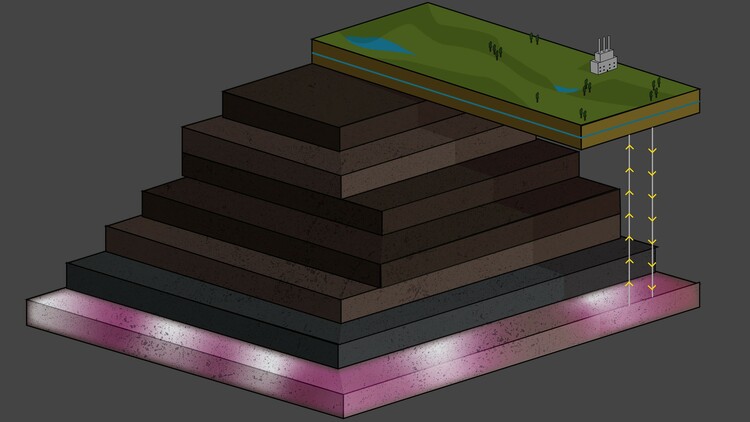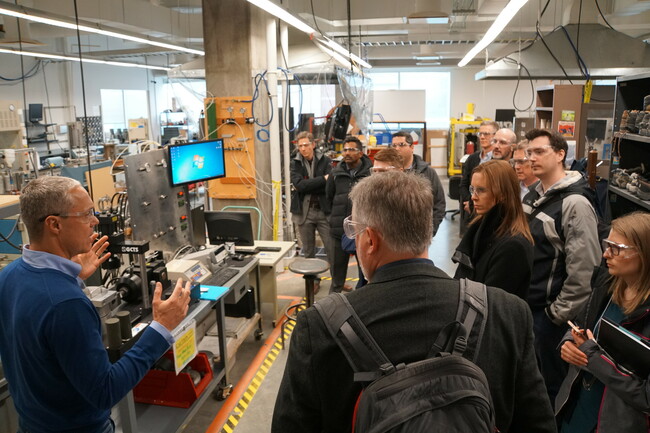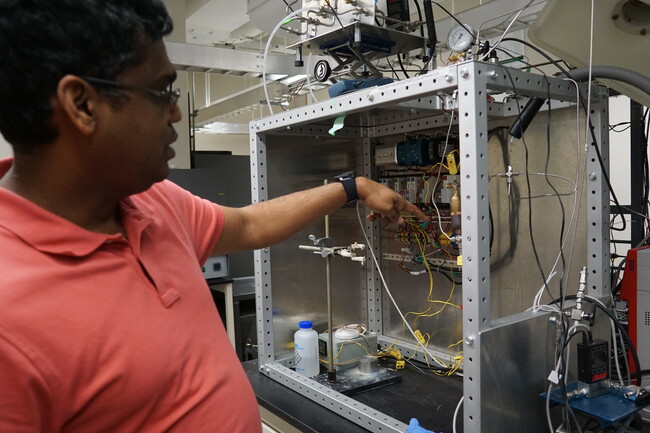What in the (geological) well is carbon capture?
Posted on
Illustration of carbon capture and sequestration graphic by Kaitlin Pylypa
Carbon Capture, Utilization, and Storage (CCUS)—we’ve all heard the phrase, especially when it comes to climate change conversations. CCUS is a hot topic right now in the energy space, but what is carbon capture, and why do scientists keep talking about it?
CCUS research explores methods and technologies that reduce carbon dioxide emissions resulting from power generation and industrial processes. When we burn fossil fuels or biomass to produce electricity, those emissions—largely carbon dioxide—are released into the atmosphere. Over time, the buildup of CO2 has had significant effects on our environment, contributing to anthropogenic climate change. Carbon capture technology and research aim to learn about emissions, how to solve the buildup, and how to reduce emissions while maintaining and advancing our energy systems moving forward. In other words, they play an important role in global energy and climate goals.
Carbon capture and storage technology is not ‘new’, per se. Researchers have been exploring CCUS as a solution to greenhouse gas reductions for decades. In fact, University of Alberta civil engineering professor Dr. Rick Chalaturnyk has had his hands on this technology for over 25 years. He currently runs the Reservoir Geomechanics Research Group (RG2), which dedicates itself to subsurface management and optimization with geomechanics. One of the current focuses of this group is the geological storage of carbon dioxide (or the ‘S’ in CCUS). Because of his expertise in subsurface geomechanics and geological storage of carbon dioxide, Dr. Chalaturnyk is a member of the scientific and research committee for the Saskatchewan-based Aquistore project.

Proving effective carbon dioxide storage
Aquistore was initiated in 2009 and construction began in 2014. It’s the world’s first commercial-scale deep saline storage of post-combustion carbon dioxide. The project is located near the Boundary Dam Power Station in Saskatchewan, Canada, and it captures CO2 emissions, which are then stored for Enhanced Oil Recovery or permanent storage.
Recently, the Aquistore project reached 500,000 tonnes of permanently stored carbon dioxide; a milestone that’s equivalent to taking 125,000 vehicles off the road for one year. Since Aquistore is Canada’s first deep saline aquifer storage project, the project plays an important role in providing data for carbon capture research. In fact, the project hosts government and industry partners from Canada, Japan, Korea, Australia, the United States, South Africa and the United Kingdom.
To ensure that storing carbon dioxide deep underground is a safe and reliable method of decreasing greenhouse gas emissions, there are several criteria that must be met. The main three are capacity, injectivity, and containment. As a geomechanics researcher, one of Dr. Chalaturnyk’s research focuses is on understanding factors that affect storage capacity and containment, such as temperature changes and geological qualities.
Capturing the carbon emissions
There are four methods to reduce CO2 emissions when hydrocarbons are burned: oxy-combustion, pre-combustion, post-combustion, and direct air capture. Oxy-combustion is the use of oxygen instead of air for fuel, which results in water vapour emissions. In pre-combustion, hydrogen is separated from CO2, and then burned without resulting in carbon emissions. Direct air capture, though a type of carbon capture method, is considered negative emissions and not strictly for reducing carbon emissions. With this method, carbon dioxide is captured directly from the atmosphere when air is circulated through specialized particles that absorb and hold onto CO2. Like most power plants, the Aquistore project utilizes post-combustion carbon capture technology to separate CO2 from exhaust gases with the use of solvents or sorbents after the combustion process.
Dr. Arvind Rajendran, a chemical and materials engineering professor at the University of Alberta, has focused his research on post-combustion carbon capture using solid sorbents. This process means that when exhaust gases pass through solid sorbents they are adsorbed: the carbon dioxide sticks to the sorbent instead of being released into the atmosphere. The sorbent is regenerated either by lowering pressure or increasing temperature. Compared to liquid solvents, reticular chemistry has created the possibility of synthesizing hundreds of thousands of sorbents for CO2 capture. However, picking the right one for a specific capture application is challenging.

Dr. Rajendran’s research uses meta-models that leverage machine learning to reduce computational efforts and validate the data against current models and experiments. The end goal is to identify new solid sorbents and find a way to integrate the optimal sorbents into power, cement, or steel plants at-scale in order to reduce parasitic energy. Recently, a pan-Canadian research team comprising of members from the University of Calgary, the University of Alberta and the University of Ottawa, and Svante, a company specializing in CO2 capture from B.C., reported a major advancement that has moved sorbent-based CO2 capture at industrial scales.
How are we utilizing captured carbon emissions?
Carbon capture technology has been identified as an important solution for mitigating climate change impacts by both the International Energy Agency (IEA) and the Intergovernmental Panel on Climate Change (IPCC). Both organizations highlight not just the capture and storage of carbon dioxide, but also the utilization of carbon. So other than capturing and storing carbon dioxide, what can we do with it and how does it get used?
At the Aquistore project, most of the carbon dioxide captured is used in enhanced oil recovery (EOR), a method of hydrocarbon recovery that involves injecting water or other fluids to extract crude or heavy oil or bitumen. The IPCC acknowledges that the economic benefits of this recovery method mostly depend on oil prices. Still, the benefits of EOR combined with geological storage can actually offset some of the costs of capture and storage. In some cases, EOR can even be considered “carbon-negative oil”.
The formation of carbon black is another potential use that is being explored in an FES research project co-led by Dr. Larry Kostiuk and Dr. Marc Secanell. Their research seeks to understand how the carbon black particles—which are micron and sub-micron particles resulting from coal and hydrocarbon combustion—can be captured and transformed into valuable materials or used in pyrolysis.
The research extends to controlled combustion systems, like in industrial processes, as well as uncontrolled systems, such as wildfires. Whereas most industrial combustion processes have some sort of way to mitigate carbon black emissions, uncontrolled systems have no way to control the amount of carbon black released during combustion and thus release higher amounts of carbon black.
Due to its useful properties, carbon black is used in many industrial processes like rubber and tire manufacturing, plastic manufacturing, batteries, and agriculture. Carbon black is even used in some high-performance coatings since it has UV protection properties.
Recognizing the potential of CCUS
At Future Energy Systems (FES), CCUS research has been the forefront for a wide range of related projects. In fact, one of our strategic priorities is Developing Hydrocarbons Sustainably, and FES is currently funding 10 research projects directly related to CCUS.
Since 2018, industry interest in and support for carbon capture and storage technologies has gained significant momentum. Commercial events and conferences have also dedicated panels and discussions to carbon capture. Williston Basin Petroleum Conference, for example, was moved to Regina, Saskatchewan to feature the Saskatchewan CCUS Summit for its 30th anniversary.
However, organizations like the International Energy Agency still call for more investment in and development of CCUS technology on a commercial scale in order to reach climate goals. There is also a greater need for policy support and legal and regulatory frameworks when it comes to action from governments. Steps like these foster growth in the energy sectors, and incentivize employment and economic growth in the clean energy job space, which is critical if we want to meet net-zero targets.
Future Energy Systems Research related to CCUS
- Thermal impacts for geological storage of CO2
- Transforming fossil fuels into heat or hydrogen
- Post combustion capture of CO2 using solid sorbents
- Value added conversion of CO2
- Advancing containment, conformance and injectivity technologies for effective geological storage of CO2
- CO2 dissolution in saline pore fluids and CO2 EOR
- Understanding and modelling black carbon formation
- Kinetics of CO2 hydrate formation
- Uncertainty quantification and optimization for the scale-up of geological carbon storage
Further reading about carbon capture, utilization, and storage
- [RG] 2 The Reservoir Geomechanics Research Group
- Aquistore
- Aquistore has stored 500,000 tonnes of CO2 since opening - SaskToday.ca
- Aquistore: CO2 storage at the world’s first integrated CCS project. Project summary report.
- Carbon capture and storage could still play a major role in mitigating emissions
- 21st Century Energy Transition: how do we make it work?
- Carbon-capturing material invented in Alberta could help industry reduce emissions and costs | Folio
- Carbon Capture, Utilisation and Storage – Analysis - IEA
- Carbon Dioxide Capture and Storage — IPCC
- Enhanced Oil Recovery | Alberta Energy Regulator
- Chapter 8: Cost and economic potential
- Can CO2-EOR really provide carbon-negative oil? – Analysis - IEA
- Uses of Carbon Black — ICBA